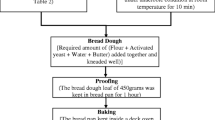Abstract
In view of the wider consumption of bakery products, they could be good choice for the delivery of functionality. The present study attempts to develop a functional formulation of bread by incorporation of shatavari (Asparagus racemosus Willd.), which is an important medicinal plant of India. Central composite rotatable design (CCRD) was used for experiments in which yeast and shatavari powder were taken as variables. Response surface methodology (RSM) was used to optimize the bread formulations on the basis of hardness, adhesiveness, springiness, chewiness and cohesiveness as responses. Qualitative tests were performed for assessing the presence of phytochemicals in shatavari bread. Sensory attributes of the shatavari bread were evaluated using descriptive analysis technique. The optimum acceptable level for shatavari and yeast in bread was found to be 3.5 % and 4.96 %, respectively. All the phytochemicals such as alkaloid, steroid, terpenoid and saponin present in original herbs were also present in bread. However flavonoids were not found in the bread when analysed qualitatively and using TLC.

Similar content being viewed by others
References
Abdelghafor RF, Mustafa AI, Ibrahim AM, Krishnan PG (2011) Quality of bread from composite flour of sorghum and hard white winter wheat. Adv J Food Sci Tech 3:9–15
Anon (2007) The Ayurvedic Pharmacopia of India, Part I, vol IV, 1st edn. Dept of AYUSH, Ministry of Health and Family Welfare, GOI, New Delhi
Artan MY, Karim R, Chern BH, Arrifin AA, Man YC, Chin NL (2010) The influence of different formulations of palm oil/palm stearin-based shortenings on the quality of white bread. Middle East J Sci Res 5:469–476
Ashajyothi V, Rao PS, Satyavati D (2009) Asparagus Racemosus - A phytoestrogen. J Pharm Tech 1:36–47
Bopana N, Saxena S (2007) Asparagus racemosus - Ethnopharmacological evaluation and conservation needs. J Ethnopharmacol 110:1–15
Carson L, Sun XS (2001) Creep-recovery of bread and correlation to sensory measurements of textural attributes. Cereal Chem 78:101–104
Collar C, Santos E, Rosell CM (2007) Assessment of the rheological profile of fiber-enriched bread dough by response surface methodology. J Food Eng 78:820–826
Curic D, Novotni D, Skevin D, Rosell CM (2008) Design of a quality index for the objective evaluation of bread quality: Application to wheat breads using selected bake off technology for bread making. Food Res Int 41:714–719
Flander L, Salmenkallio-Marttila M, Suortti T, Autio K (2007) Optimization of ingredients and baking process for improved wholemeal oat bread quality. Food Sci Tech 40:860–870
Goel RK, Prabha T, Kumar MM, Dorababu M (2006) Tetratogenicity of Asperagus racemosus Willd. Root, aherbal medicine. Ind J Exp Bio 44:570–573
Harborne JB (1998) Phytochemical methods: a guide to modern techniques of plant analysis, 3rd edn. Chapman and Hall, New York
Hayes PY, Jahidin AH, Reg L, Kerry P, William K, James DV (2008) Steroidal saponins from the roots of Asparagus racemosus. Phytochem 69:796–804
HsiaFen H, ChaoLin C, YanHwa C (2000) Flavonoid contents and antioxidative activities of several vegetables. Taiwan J Agr Chem Food Sci 38:377–387
Jaworska D, Hoffmann M (2008) Relative importance of texture properties in the sensory quality and acceptance of commercial crispy products. J Sci Food Agr 88(10):1804–1812
Kaack K, Pedersen L, Laerke HN, Meyer A (2005) New potato fibre for improvement of texture and colour of wheat bread. Eur Food Res Tech 224:199–207. doi:10.1007/s00217-006-0301-5
Kamaljit K, Baljeet S, Amarjeet K (2010) Preparation of bakery products by incorporating pea flour as a functional ingredient. Am J Food Technol 5:130–135
Myers RH (1971) Response surface methodology. Allyn and Bacon, Boston, MA, pp 1–2
Setser CS (1993) Sensory evaluation. In: Kamel BS, Stauffer CE (eds) Advances in baking technology. Blackie Academic & Professional, Glasgow, UK, pp 254–291
Singh GS, Sehgal, Kawatra A (2006) Sensory and nutritional evaluation of cake developed from balanced and malted pearl millet. J Food Sci Technol 43(5):505–508
Upadhyay A, Sharma HK, Sarkar BC (2008) Characterization and dehydration kinetics of carrot pomace. Agr Eng Int - CIGR Ejournal 10:1–9
Vassallo M, Saba A, Arvola A, Dean M, Messina F, Winkelmann M, Claupein E, Lahteenmaki L, Shepherd R (2009) Willingness to use functional breads: applying the health belief model across four European countries. Appetite 52:452–460
Velavan S, Nagulendran K, Mahesh HB (2007) In vitro antioxidant activity of Asparagus racenosus root. Pharmaco Map 3:26–33
Author information
Authors and Affiliations
Corresponding author
Rights and permissions
About this article
Cite this article
Singh, N., Jha, A., Chaudhary, A. et al. Enhancement of the functionality of bread by incorporation of Shatavari (Asparagus racemosus) . J Food Sci Technol 51, 2038–2045 (2014). https://doi.org/10.1007/s13197-012-0731-y
Revised:
Accepted:
Published:
Issue Date:
DOI: https://doi.org/10.1007/s13197-012-0731-y




